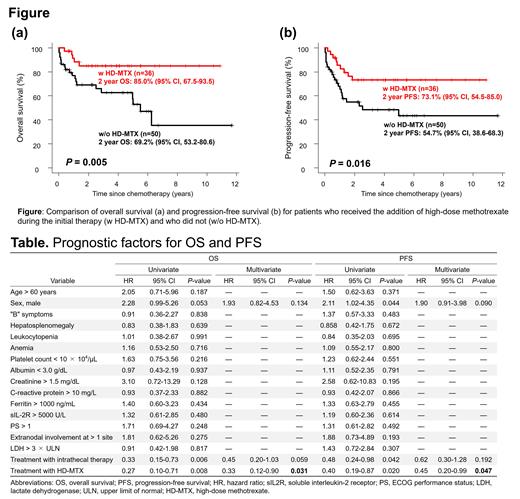[Introduction] Intravascular large B-cell lymphoma (IVLBCL) is a rare subtype of diffuse large B-cell lymphoma characterized by selective growth of lymphoma cells in the lumina of small vessels. Although the clinical outcomes of IVLBCL before rituximab era were dismal, a retrospective analysis published in 2008 showed improved outcomes for patients treated with rituximab-containing chemotherapy (R-chemo). Furthermore, a recent multicenter, single-arm, phase II trial conducted in Japan (PRIMEUR-IVL study) supports the usage of rituximab, cyclophosphamide, doxorubicin, vincristine, and prednisone combined with high-dose methotrexate (HD-MTX) and intrathecal chemotherapy (IT), with a 2-year Overall survival (OS) of 92% and 2-year progression-free survival (PFS) of 76% in a selected population with newly diagnosed IVLBCL. However, this trial did not include a control arm, making it difficult to evaluate whether the addition of HD-MTX improves the treatment outcome. Thus, with the largest cohort (we already reported at ASH 2022), we retrospectively evaluated the efficacy of the HD-MTX in real-world settings. [Methods] Patients with histopathologically proven newly diagnosed IVLBCL according to the 2008 World Health Organization criteria between January 2010 through February 2022 from hospitals participating in the North Japan Hematology Study Group were included. Survival analysis was limited to patients with serum creatinine < 2.0 mg/dL and aged 20-79 years, following the eligibility criteria of the PRIMEUR-IVL study. PFS was defined as the time from the start of treatment to the first of progression, relapse, or death from any cause. Patients undergoing upfront autologous stem-cell transplantation (auto-SCT) were censored at the time of transplantation. [Results] A total of 110 IVLBCL cases were identified. Eighty-six patients with serum creatinine < 2.0 mg/dL, aged 20-79 years, received chemotherapy. Eighty-five of 86 patients (98.8%) received R-chemo. Thirty-six of 86 patients (41.9%) received HD-MTX during the initial therapy (w HD-MTX group), and 50 patients (58.1%) did not (w/o HD-MTX group). Fifty-six patients (65.1%) received IT. Six patients (7.0%) received upfront auto-SCT. Complete response (CR), no change (NC), and primary refractory disease were noted after initial therapy by 62 (72.1%), 11 (12.8%), and 11 (12.8%) patients, respectively. The disease progression after achieving NC was noted in 3 patients (3.5%). Fourteen patients (16.3%) experienced a relapse after achieving CR. Eight of 28 recurrences (progressions or relapses) were neurolymphomatosis forms, and 7 were central nervous system (CNS) recurrences. Twenty-five patients (29.1%) died, and 21 were due to disease progression. Compared clinical characteristics of the w HD-MTX group with the w/o HD-MTX group, the proportion of patients older than 60 years, male sex, poor performance status (ECOG PS > 1), elevated serum LDH, Ann Arbor stage III-IV and 2 or more extra-nodal lesions were not significantly different. The number of patients who received IT was significantly higher in the w HD-MTX group (77.8% vs. 56.0%, P = 0.042). Median follow-up duration for censored cases was 47.1 months (range, 7.4-130.7 months) in w HD-MTX group and 33.0 months (range, 1.78-140.5 months) in w/o HD-MTX group. Two-year PFS and OS were 73.1% (95% CI, 54.5-85.0) and 85.0% (95% CI, 67.5-93.5), respectively, in the w HD-MTX group and 54.7% (95% CI, 38.6-68.3) and 69.2% (95% CI, 53.2-80.6), respectively, in the w/o HD-MTX group (log-rank test, P = 0.016 and P = 0.005, respectively; Fig. a, b). The w HD-MTX group and the w/o HD-MTX group showed no significant difference in the cumulative incidence of CNS recurrence at 2 years (8.7%; 95% CI, 2.2-21.0 vs. 6.6%; 95% CI, 1.7-16.5, Gray test, P = 0.98). In univariate analysis, male gender, the addition of IT, and the addition of HD-MTX were significantly associated with PFS and OS ( Table). Multivariate analysis demonstrated that the addition of HD-MTX was independently associated with both PFS and OS. No HD-MTX-related deaths occurred in the w HD-MTX group. Adverse events related to HD-MTX were observed in 24 of 36 patients (66.7%), with grade 3 or 4 non-hematological adverse events in 3 patients (8.3%). [Conclusion] In conclusion, this largest retrospective study showed that the addition of HD-MTX to initial chemotherapy improved the treatment outcome of patients with newly diagnosed IVLBCL.
Disclosures
Horiguchi:Abbvie pharmaceutical: Honoraria; Chugai pharmaceutical: Honoraria; Kyowa Kirin: Honoraria; Janssen pharmaceutical K.K: Honoraria; Otsuka Pharmaceutical: Research Funding. Nakagawa:Mundipharma: Honoraria; Astrazeneca: Honoraria; Meiji Seika pharma: Honoraria; AbbVie Inc.: Research Funding; Takeda Pharmaceutical Company Limited: Honoraria, Research Funding. Hashimoto:LUCA Science: Patents & Royalties; Ono Pharma: Honoraria; Daiichi Sankyo Inc: Honoraria; Kyowa-Kirin: Honoraria; Janssen Pharma: Honoraria; Chugai Pharmaceutical: Honoraria; Astellas Pharma: Honoraria. Teshima:Novartis: Honoraria, Membership on an entity's Board of Directors or advisory committees; AbbVie: Honoraria; Merck Sharp & Dohme: Honoraria; Bristol-Myers Squibb: Honoraria; Sumitomo Pharma: Honoraria, Membership on an entity's Board of Directors or advisory committees, Research Funding; Eisai: Research Funding; Celgene: Honoraria, Membership on an entity's Board of Directors or advisory committees; ONO: Research Funding; Astellas: Honoraria, Membership on an entity's Board of Directors or advisory committees, Research Funding; SHIONOGI: Research Funding; Janssen: Honoraria, Membership on an entity's Board of Directors or advisory committees; Meiji Seika Pharma: Membership on an entity's Board of Directors or advisory committees; DAIICHI SANKYO: Membership on an entity's Board of Directors or advisory committees; AstraZeneca: Membership on an entity's Board of Directors or advisory committees; Takeda: Membership on an entity's Board of Directors or advisory committees; Roche Diagnostics: Membership on an entity's Board of Directors or advisory committees; Sanofi: Membership on an entity's Board of Directors or advisory committees; Priothera SAS: Research Funding; Otsuka: Research Funding; LUCA Science: Research Funding; Chugai: Honoraria, Research Funding; Fuji Pharma: Research Funding; Kyowa Kirin: Honoraria, Research Funding; NIPPON SHINYAKU: Honoraria, Research Funding; Asahi Kasei Pharma: Membership on an entity's Board of Directors or advisory committees, Research Funding.


